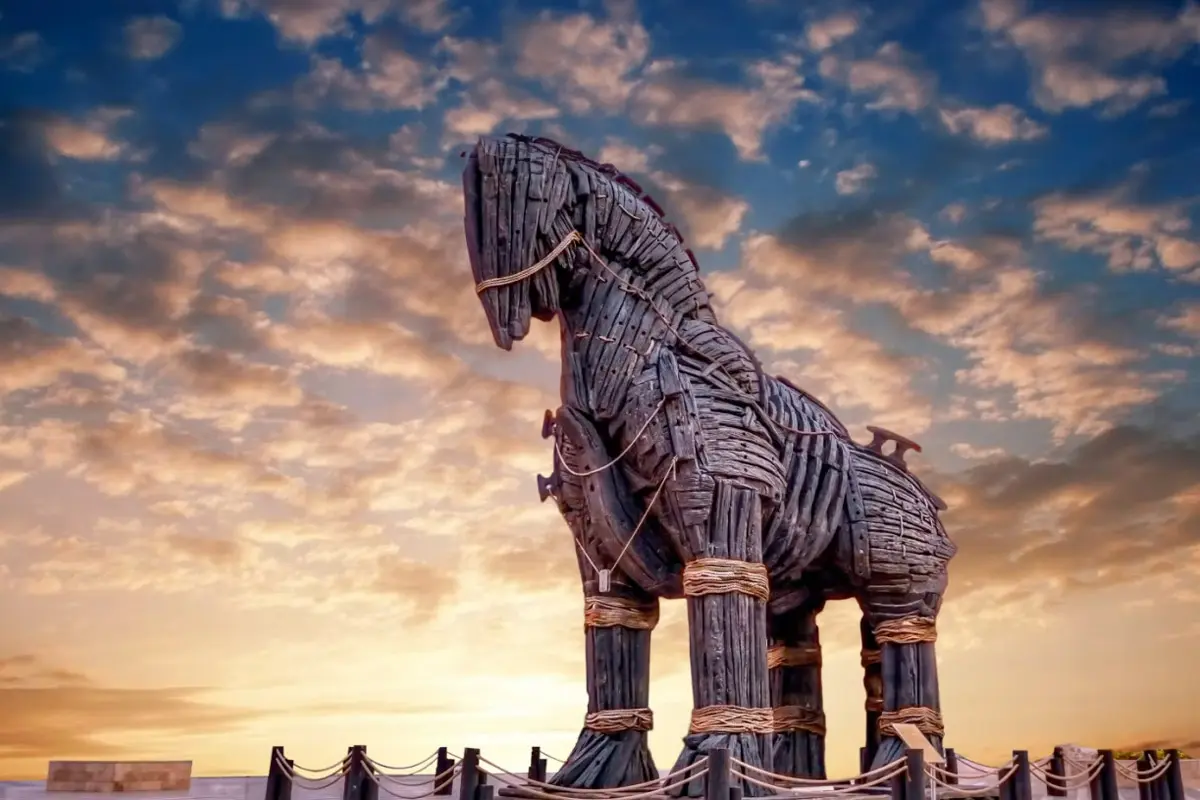What comes to mind first when we hear the name “Çanakkale” is Gallipoli, the Aynalı Çarşı (Mirror Bazaar) and the ancient city of Troy.
The places where the Gallipoli campaign took place are mostly frequented by local and Australian tourists. The ancient city of Troy, added in 2006 to the UNESCO World Heritage List, attracts visitors from all countries. Troy, the place where the world’s first recorded war took place, was visited by 70,000 people a year 15 years ago, but this number now exceeds 500,000 annually. The movie “Troy,” which starred Brad Pitt, played a role in this increase. The giant wooden horse that housed Greek soldiers in the film has been brought from Japan to Çanakkale for exhibition purposes. Local and foreign tourists are showing great interest in the horse, exhibited at Morabbin Park in Çanakkale’s city center.
The ancient city of Troy was founded 4,000 years ago, and lasted until A.D. 500 and was destroyed and rebuilt several times on the same foundations, the head of excavation at Troy, Profesor Rüstem Aslan, informed us. Destroyed nine times and re-established on the same site, Troy is very rich in terms of historical artifacts. The Troy we see today is known to historians as Troy VI.
Giving information on the city, Professor Aslan said: “The city, which was apparently destroyed in an earthquake, was immediately replaced by Troy VII. This Troy VII was Priam’s Troy, which was destroyed, using the famous deception of the “wooden horse,” by the Achaeans. In the war Homer told about in his great legend, the Trojan allies were the Carians, Lycians and Amazons living in Asia Minor. The first excavations were done by German archaeologist Heinrich Schliemann. Treasures found in the west of the city and removed, believed to have belonged to King Priam, constitute the most famous elements of Trojan history. The treasures taken away by Schliemann are preserved at the Pushkin Museum in Russia today.”
Bank officer Bülent İnce stated that his family came from İstanbul to Çanakkale to see historical and tourist sites and said: “We would normally go to Antalya on every holiday, but this year my children wanted to come here. They had seen the movie ‘Troy,’ which they liked very much, and we decided to come here. Actually, I had visited this place with my friends before the movie. I wanted my kids to see this place. We first visited the Gallipoli Peninsula Historical National Park. We then crossed the strait and saw the wooden horse used in the film. Afterwards, we visited the ancient city of Troy accompanied by a guide. My wife and kids were impressed by the stories told. There are only stone monuments; it would have been better if the treasures found were exhibited here.”
A retired teacher from Germany, Henrik Würtela, who came to see the ancient city of Troy with his wife said they frequently come to Turkey and see Troy every time. Emphasizing that Troy has a very mysterious history and that mystery emerges as excavations continue, Würtela said he got to know both the ancient city of Troy very closely as well as Professor Manfred Korfmann, the deceased head of the excavation delegation, through several books he had read. Würtela went on as follows: “The youth in Germany came to understand the importance of the ancient city of Troy after watching the movie ‘Troy.’ As the wooden horse used in the film was brought here after the movie was shown in theaters, more young people came. The saddest thing here is that the treasures of ancient Troy are exhibited in other countries. We want a museum to be built here and for the artifacts to be displayed in their original place.”
The first official excavations in Troy were started in 1870 by Schliemann. The Trojan treasures, found in 1873, were firstly taken to Athens and then to Berlin. Dörpfeld joined the excavations in 1882 and the excavations took on a scientific aspect. Schliemann died in 1891 and Dörpfeld continued the excavations in 1893-1894 with the financial support of Schliemann’s wife, Sophia. The excavations ended at the end of 1894. The Americans again conducted excavations in 1932-1938. The excavations were restarted in 1988 by a national and international scientific team headed by Professor Manfred Korfmann with the sponsorship of Mercedes Benz and the Turkish Ministry of Culture. The Trojan excavations start in June and end in September every year.
Korfmann, who dedicated himself to the study of the ancient city of Troy, acquired Turkish citizenship and added the name Osman to his legal name two years before his death, in Germany in Aug. 11, 2005. Associate Professor Rüstem Aslan from Tübingen University, Korfmann’s assistant for some time, acted as the excavation team head for a while. Afterwards, Professor Ernst Pernicka, Korfmann’s colleague from Tübingen University, was appointed as the team head. Pernicka was responsible for the natural scientific perspectives of the 1988 excavations. Having written many books and articles on Bronze Age of Troy and the metal technology of Asia Minor, the scientist aims at finishing the excavations. Professor Aslan said Troy is situated in a bigger area than is popularly known: “We have made excavations in the last 16 years with 380 scientists over an area of 13,000 square meters. Different results are obtained everywhere. Examining the satellite photos and the topographic aspect of the area and excavations we made, we found that the region is the biggest archeological site on the continent of Europe. We have reached various conclusions that Troy at one point stretched over a total area of 270,000 square meters.”
Troy in Korfmann’s words
German Archaeologist Professor Manfred Korfmann, head of the ancient city of Troy excavation team, stated Troy was a transit point for commerce in Mesopotamia, Egypt and Asia Minor during the second millennium B.C. and gave the following information on Troy’s history during a panel discussion in 2005: “Troy was the strongest settlement at the border region at that time. The city became a powerful center, thanks to its geographical position. The majestic ramparts, which stood for a long time, are evidence of this power. When we take into consideration the dimensions of the strong ramparts and the cut of the stones, it becomes obvious that a similar settlement of such quality does not exist in Europe. If there were a settlement like the Trojan castle in Belgrade, all historians would have certainly accepted it as the center of the Balkans.” Stating that Troy was the first place in the region between Asia and Europe, where square-cut stones were used as iron had not yet been discovered, Professor Korfmann had said: “Troy was an important center and it was under threat throughout its entire history. The Trojans used iron, not much used by their contemporaries, in the towers and castles they built in an effort to defend themselves. The Trojans also built quake-proof city walls. In addition to mining, Troy was also an important center where kilns were first built.” Korfmann also pointed out that various cultural relationships could not have vanished without any trace in the border region at the Çanakkale Strait (the Dardanelles), saying, “The Bronze Age in Troy is becoming important again because this is the biggest settlement in a vast area.”

